“Take a chance as if you were jumping off the stage of Kiyomizu!” This is a famous saying, meaning “Put yourself out there, even if you are taking a risk.” Yes, this temple is famous for its stage! However, you shouldn’t be satisfied with just seeing it. Kiyomizu-dera is full of things to draw visitors! I’ll show as many attractive spots as possible here, some of which are more likely to be overlooked, especially in the crowd. Let’s get started!
1. Kubi-furi Jizo (首振地蔵)

First of all, before visiting Kiyomizu-dera, I’d like to show the unique Jizo called Kubi-furi Jizo in the small temple, Kiyomizu-Zenkoji (清水善光寺), which is on your left. Kubi-furi Jizo literally means Jizo whose neck we can turn 360 degrees. It’s said if you turn the Jizo’s head in the direction of your wish and worship it, your wish will be granted.
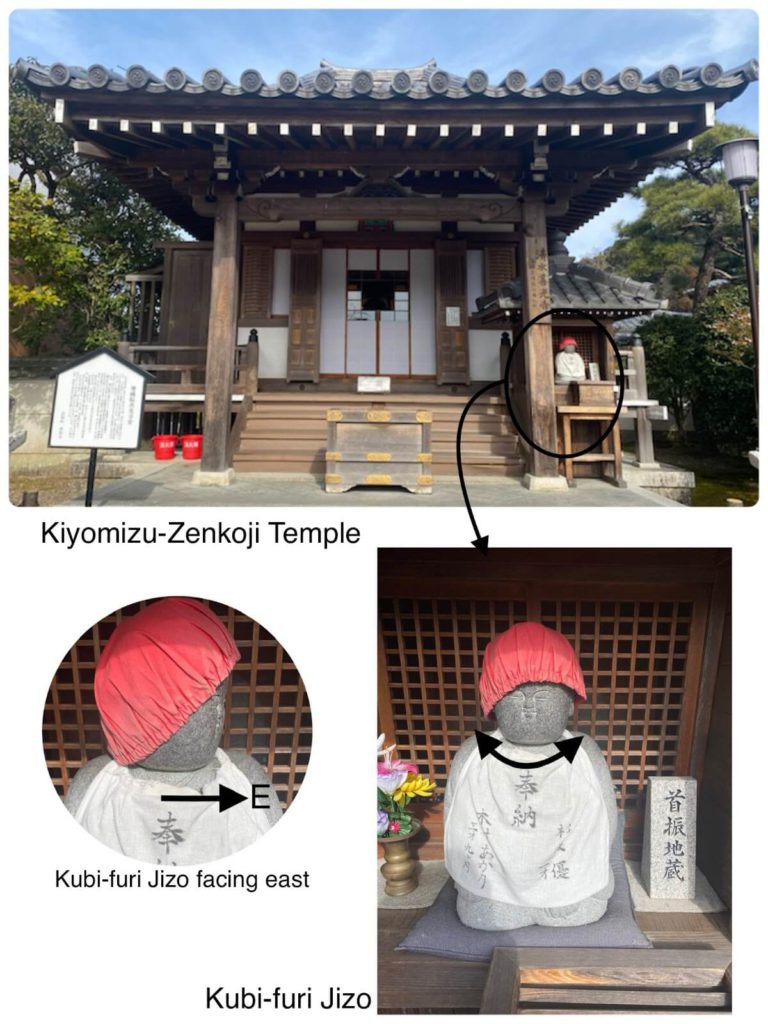
2. Uma-todome (馬駐)
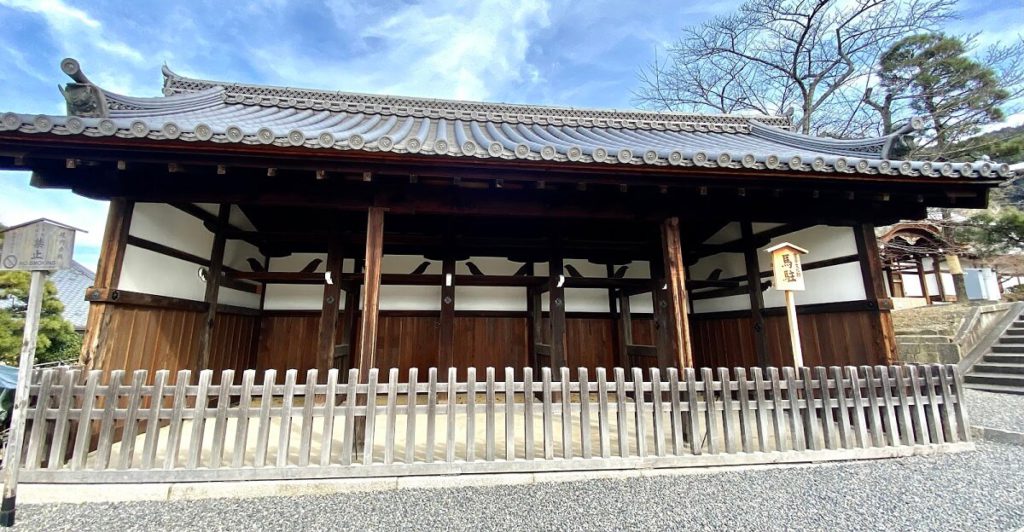
It used to be a stable, or a place for tying up and sheltering horses.
3. Koma-inu (狛犬)
Koma-inu means a pair of lion-shaped guardian dogs, which are placed at the entrance gate to protect the shrine or the temple from evil spirits. They face each other, usually one with its mouth open and the other’s closed. As you see, however, both open their mouths in this case. It’s said to be one of Kiyomizu-dera’s wonders.
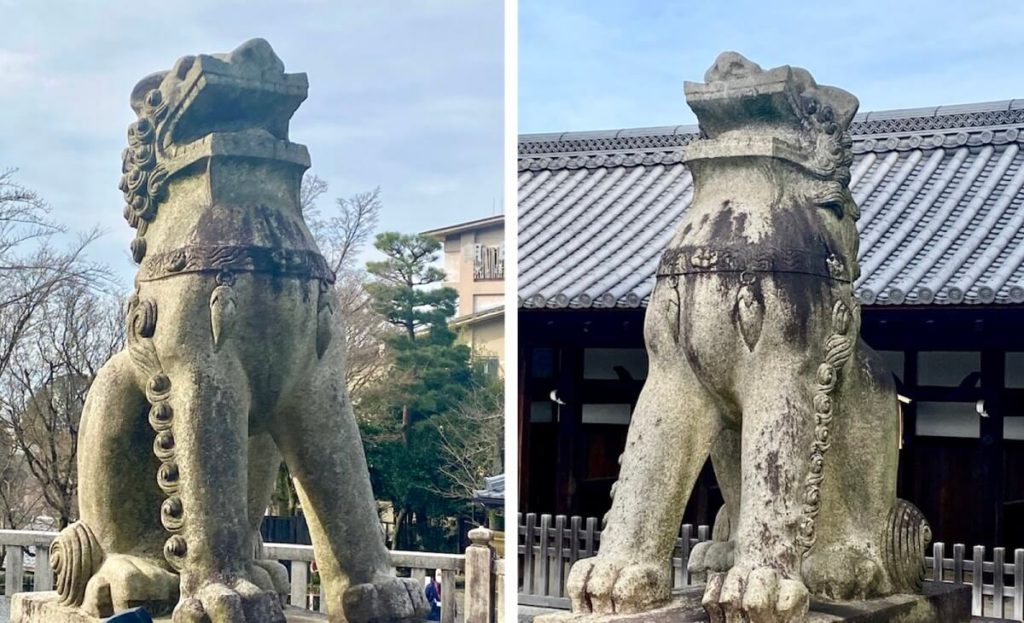
4. Nio-mon Gate (仁王門)

This is the Gate of the Deva King called Nio, who are guardian gods of the Buddha standing here to ward off intruders. The Deva King on the right opens its mouth, mouthing the sound “Ah,” which means “beginning.” The other on the left closes its mouth, saying “Un,” meaning “end.” So Ah-Un (阿吽) is considered to symbolize the beginning and the end of all things. The same can be said about typical Koma-inu mentioned above in terms of Ah-Un.
5. Shoun-Seiryu (祥雲青龍)
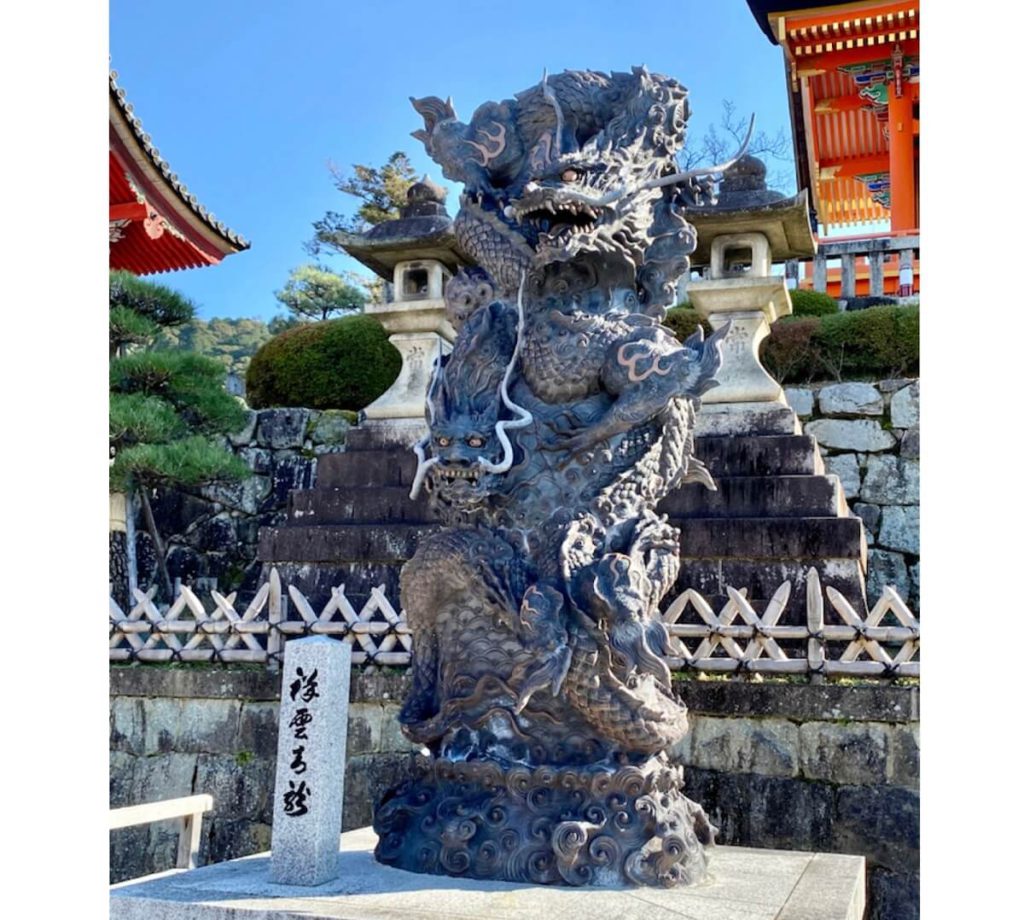
This is a statue of two powerful dragons intertwined with each other. It’s said the dragon is the embodiment of Kannon (観音), and it’s also worshiped as the god of water.
6. Bell Tower (鐘楼, Shoro)

Unlike other Bell Towers supported by four pillars, this one is unique in that it’s supported by six pillars. Please check out my other blog, “Kinkakuji -how to enjoy Kinkakuji 10 times more- – How To Japan,” about Bell Towers.
7. Zuigu-do (随求堂)
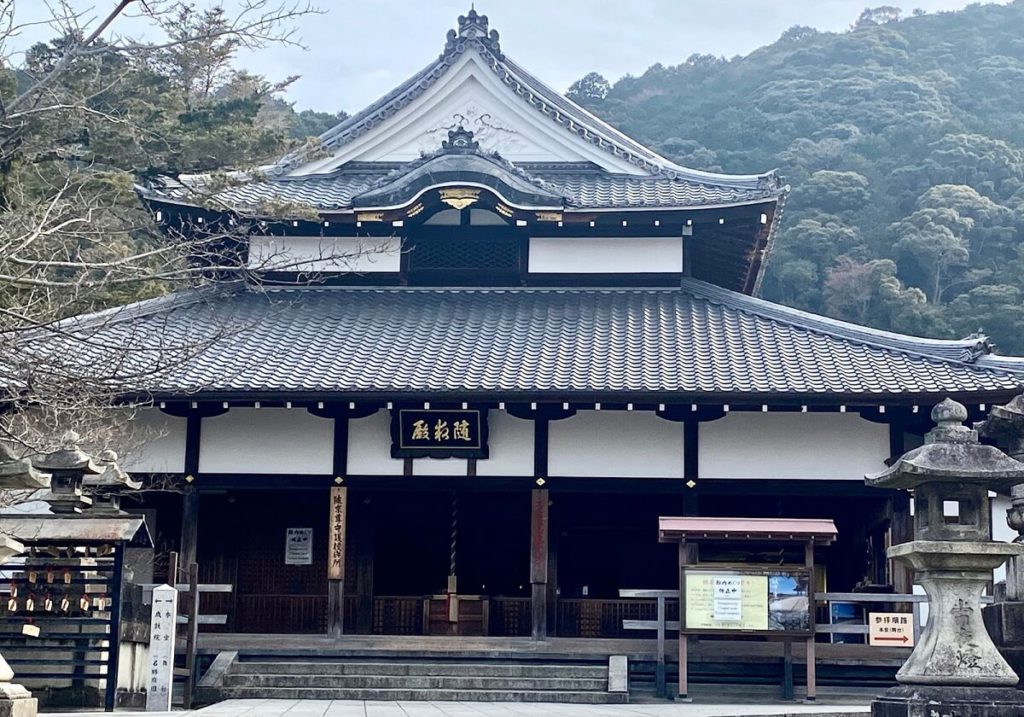
This temple is dedicated to Buddha’s mother. Stepping into the pitch-black basement, you can feel just like you are in your mother’s womb. For a few minutes, slowly walk into complete pitch black darkness while holding onto nothing but the string of a Buddhist rosary… The experience would really be something!
8. Three-story Pagoda (三重塔)

It’s 31 meters high and one of the largest three-story towers in Japan. It’s also an iconic building of Kiyomizu. You can see a dragon at the only southeast corner of the roof. As the dragon is the god of water, it protects the temple against fire.
9. Owl Washbasin (ふくろう手水鉢)
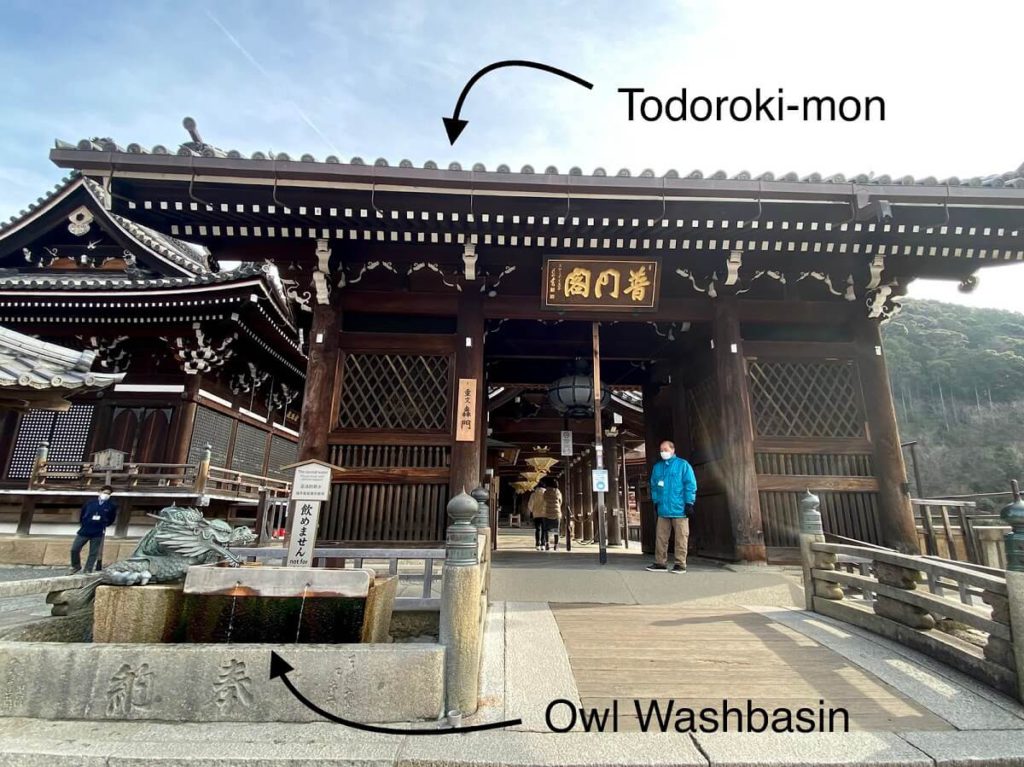
There’s a washbasin just before Todoroki-mon (轟門) Gate. It’s called Owl Washbasin, rather than Dragon. Well, where are the owls, you may ask? This basin was named after an owl at each corner of the stone under the basin. We can’t see them, though.
The word for owl is “Fukuro” (梟, ふくろう) in Japanese. This is a Japanese wordplay. “Fu” (不, ふ) is a prefix meaning “un-” or “dis-,” and “kuro”(苦労, くろう) means “trouble.” So “Fu-kuro” means “without trouble.” That’s why the owl is a symbol of happiness in Japan. We are likely to keep owl items as lucky charms or ornaments with us or in our houses.
10. Bussoku-seki (仏足石)
Bussoku-seki is a stone with Buddha’s footprints carved on it, used as an object for praying. It’s on your left, just before the Main Hall.
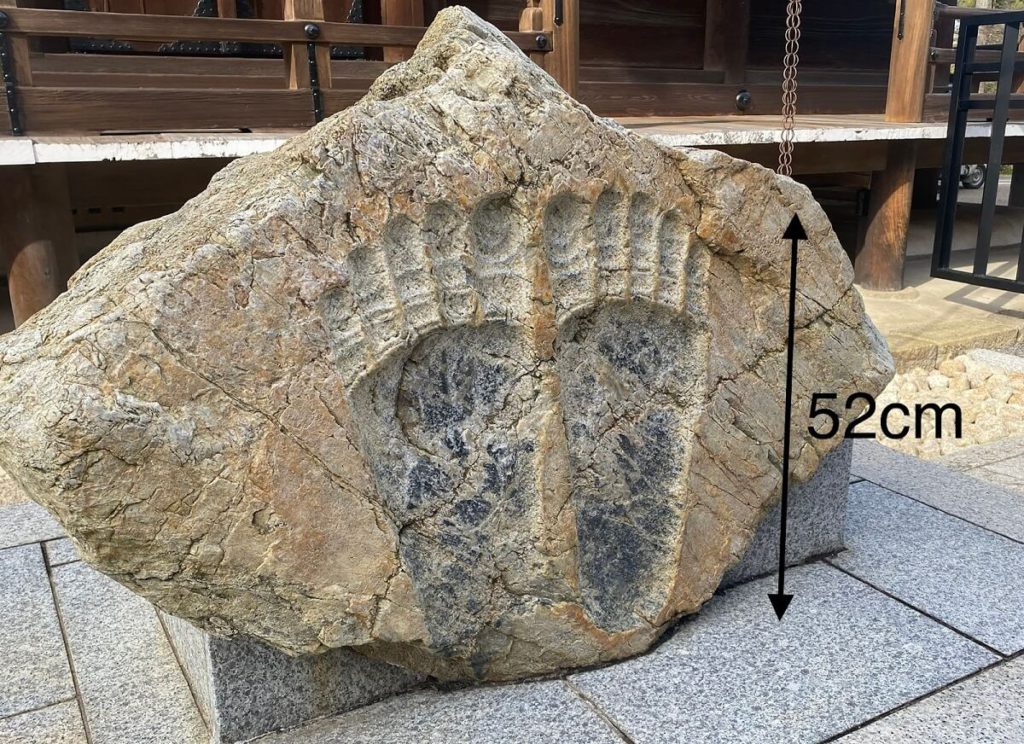
11. Iron clogs and staffs
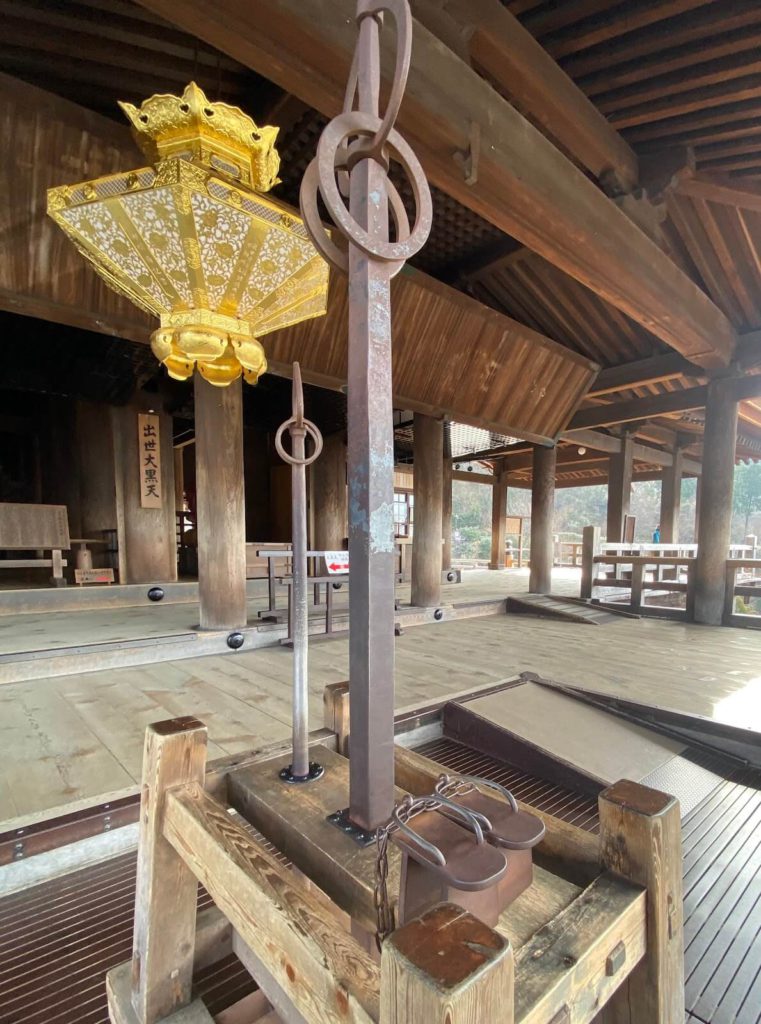
These are a pair of iron clogs and two iron staffs. One of the clogs is 12 kg (26 lbs), the bigger staff is 90 kg (200 lbs), and the smaller is 14 kg (30 lbs). Why don’t you try lifting them up! It’s said that a very strong priest called Benkei (弁慶) walked wearing these clogs with these staffs in his hands to train his body.
12. Daikoku-ten (大黒天)
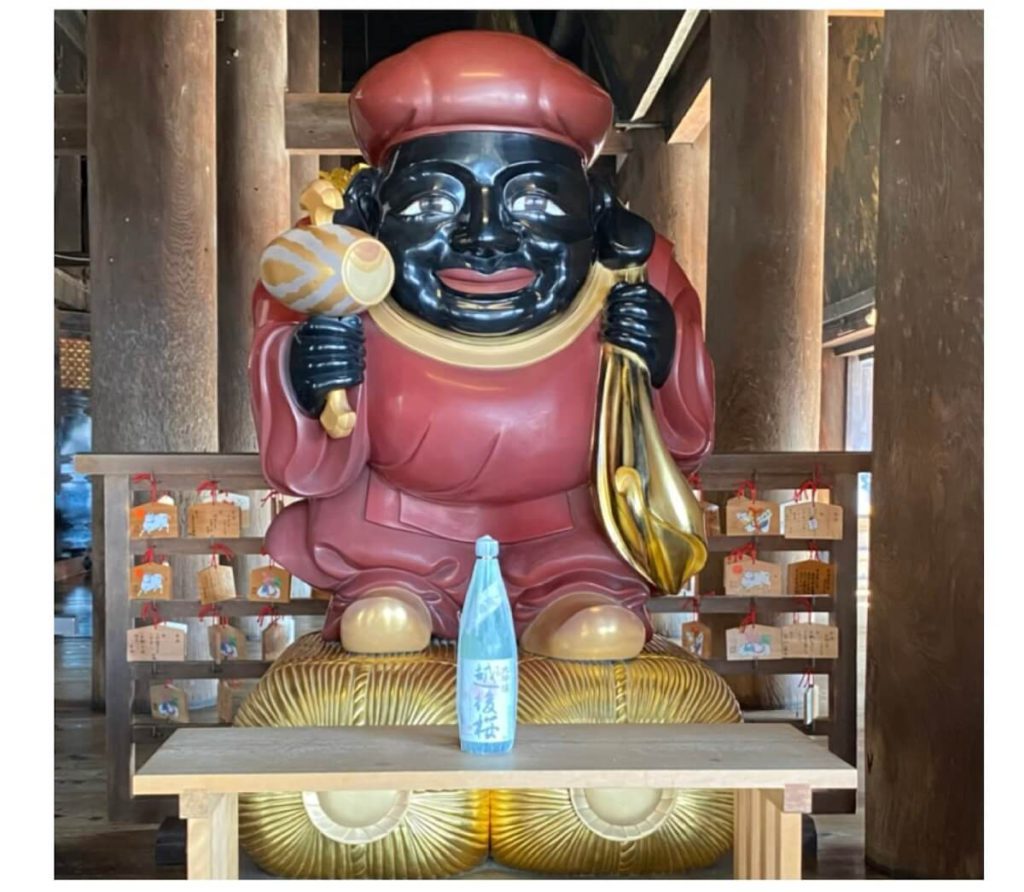
Daikoku-ten is a god of business that will guarantee you success.
13. Main Hall
The Main Hall houses the Eleven-faced Thousand-armed Kannon (十一面千手観音).
The roof, covered with layers of Japanese cypress barks, is also characteristic of this temple.
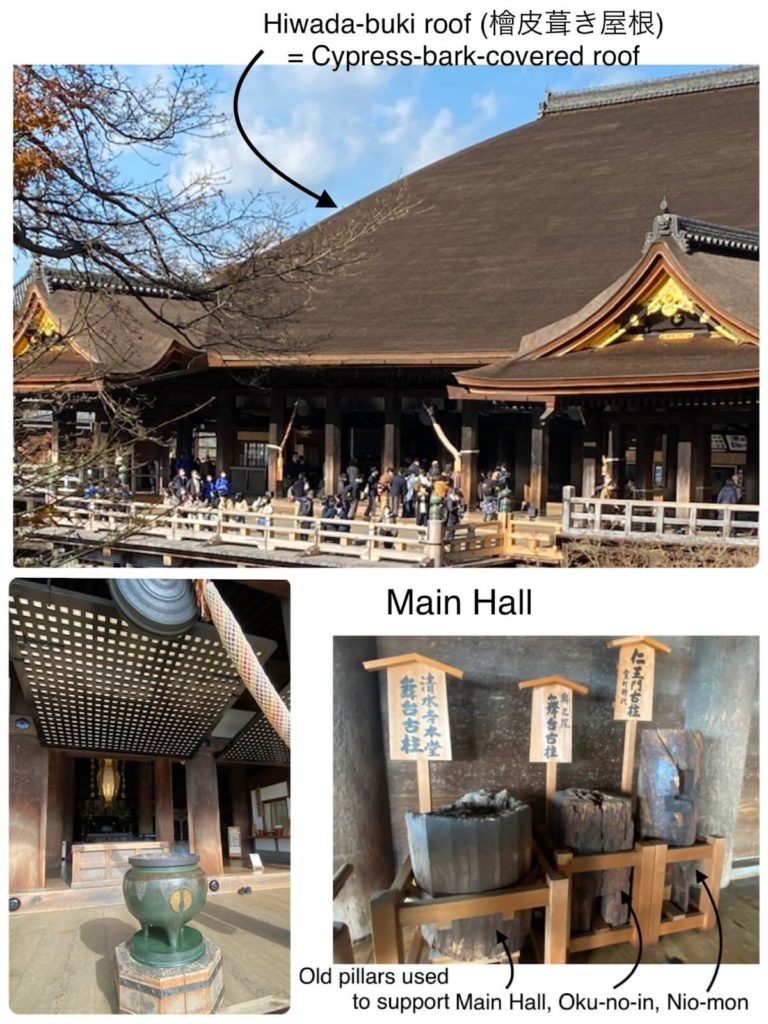
14. Stage (舞台, Butai)
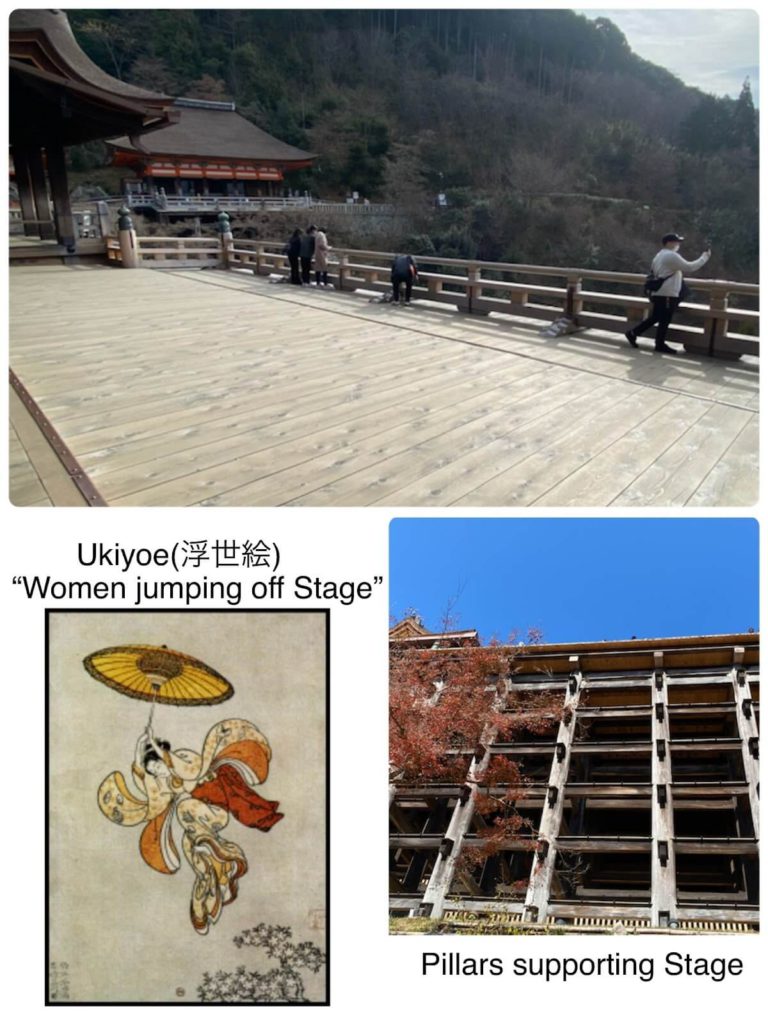
There it is! This is the well-known stage, which is 13 meters high and supported by 139 pillars without the use of nails, and yet earthquake-proof enough. Traditional Japanese building techniques are amazing, right?
Actually, the expression I mentioned in the first sentence of this article came from the fact that some people jumped off the stage to make a wish to the God. In fact, it’s been recorded that 234 people jumped off during the Edo period (from the 17th to 19th century), and 200 of them survived. Don’t you think the survival rate is high? I heard there used to be more trees below, which worked as cushions. Jumping was banned in 1872.
Is there something you’d like to challenge yourself as if you were jumping off the stage of Kiyomizu?
15. Jishu-jinja Shrine (地主神社)
You can see this shrine on your left after Main Hall. This is a shrine dedicated to the deity of matchmaking. Passing through the Torii gate, there are two stones placed 18 meters apart, which are called “Love-fortune-telling Stone.”

16. Hyaku-tai Jizo-do (百体地蔵堂)
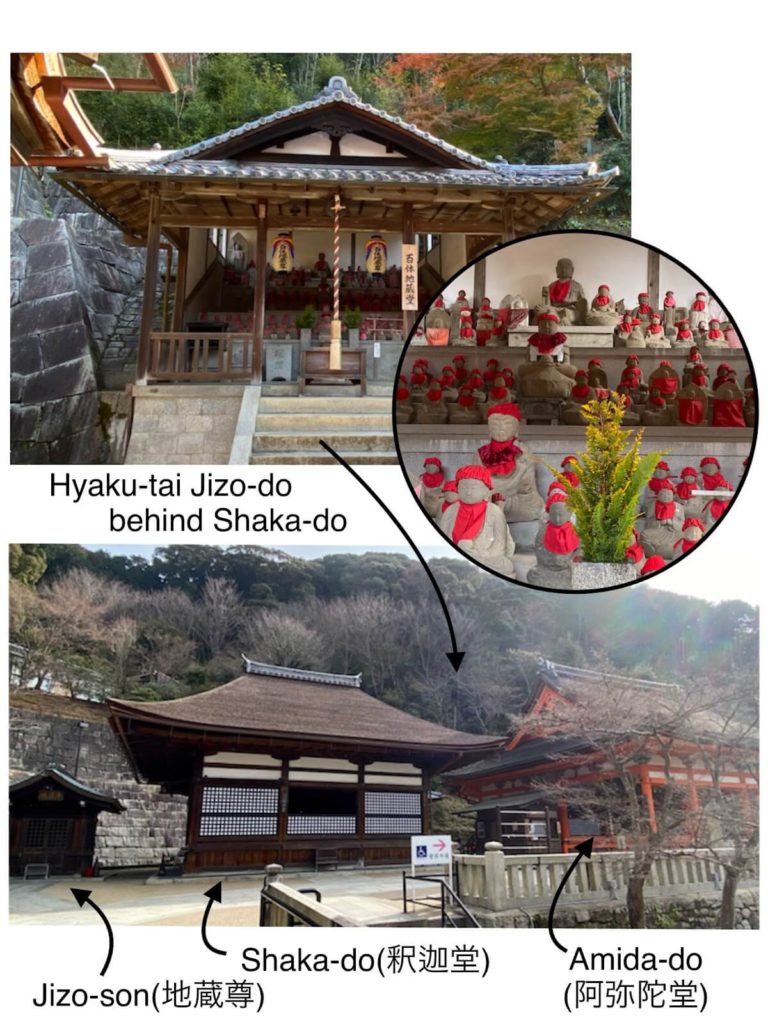
Hyaku-tai Jizo-do literally means the Hall of 100 Jizo statues. But actually, about 200 statues are here. While walking in Japan, you may notice Jizo like these on the roadside. It’s a guardian deity of children, travelers, and pregnant women.
It’s said that parents who have tragically lost their children come here to pray to these Jizo and look for a Jizo whose face resembles those of the children who have passed away.
17. Nurete Kannon (濡れ手観音)

It’s behind Oku-no-in. Gently pour water on the statue, and you can purify yourself.
18. Oku-no-in (奥の院)
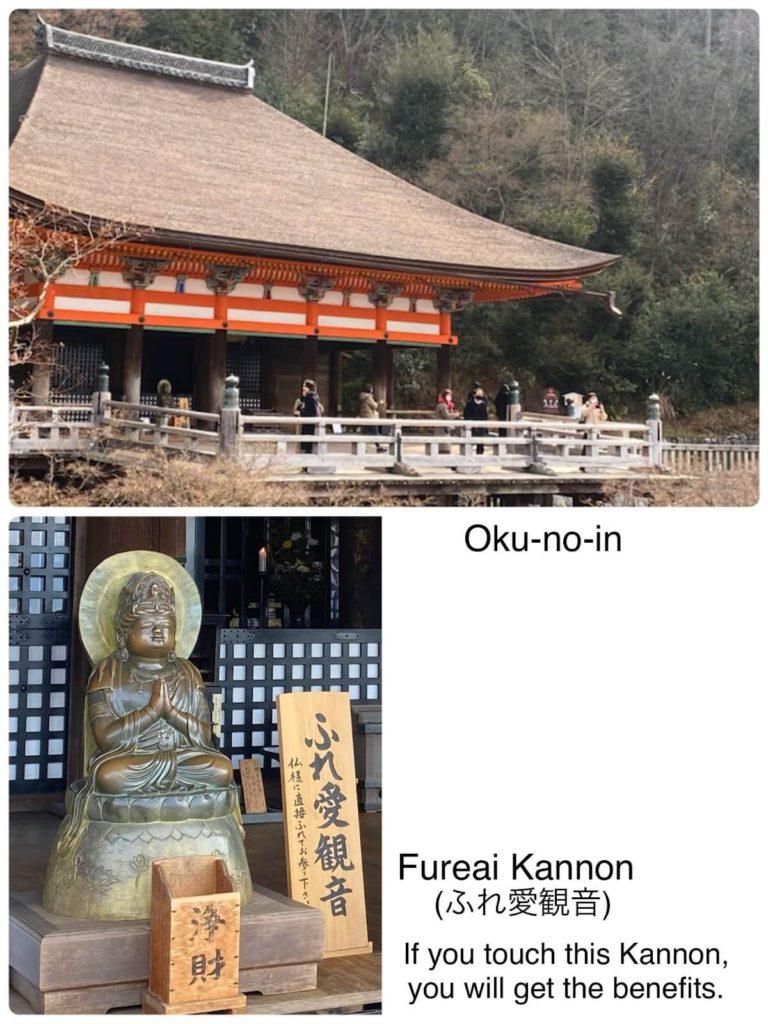
Oku-no-in has the same structure with a smaller scale of Main Hall. The Eleven-faced Thousand-armed Kannon is enshrined here as well.
The view of Main Hall from here is spectacular. This is the perfect spot to take its Instagrammable photos!
19. Koyasu-no-to Pagoda (子安の塔)
This pagoda is said to have the blessings of safe delivery.
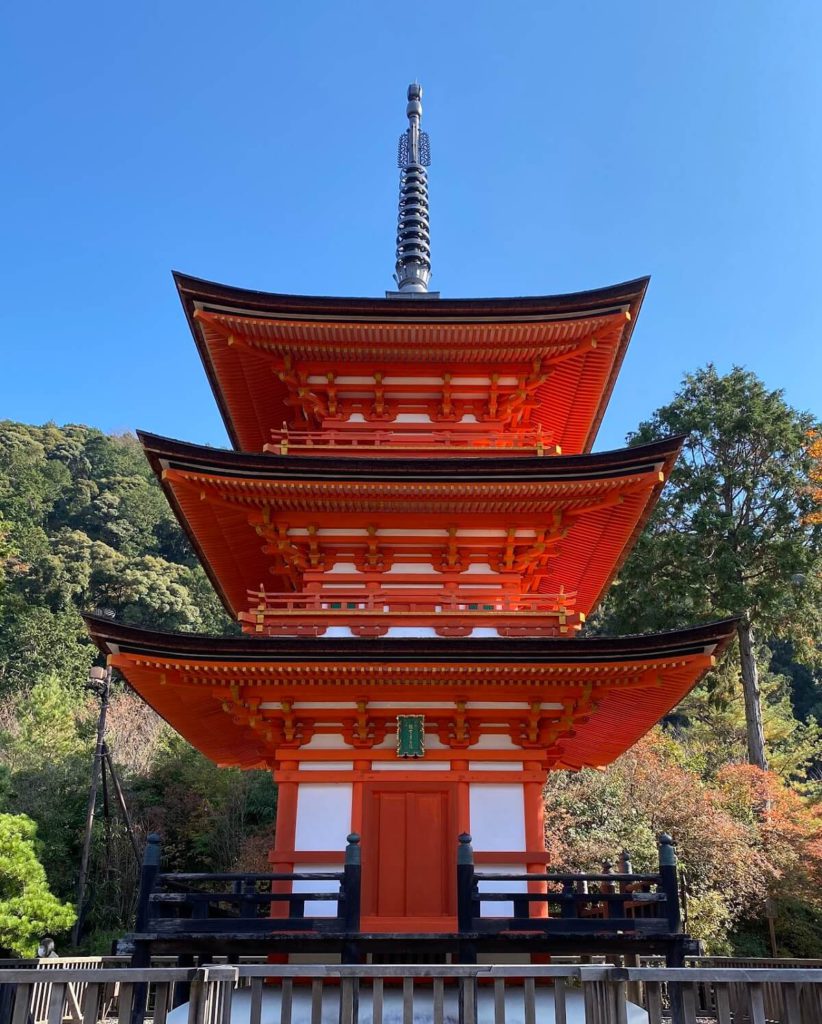
20. Otowa Waterfall (音羽の瀧)
This is also a symbolic spot here. The name of Kiyomizu-dera comes from this pure waterfall. Kiyo-mizu-dera (清-水-寺) literally means “clean-water-temple.”
The water is divided into three separate streams. Each stream’s water is said to have a different benefit, as I added in the photo below. Which one would you choose? Be sure to choose one of the three and drink it. They say drinking from all three streams is considered greedy.
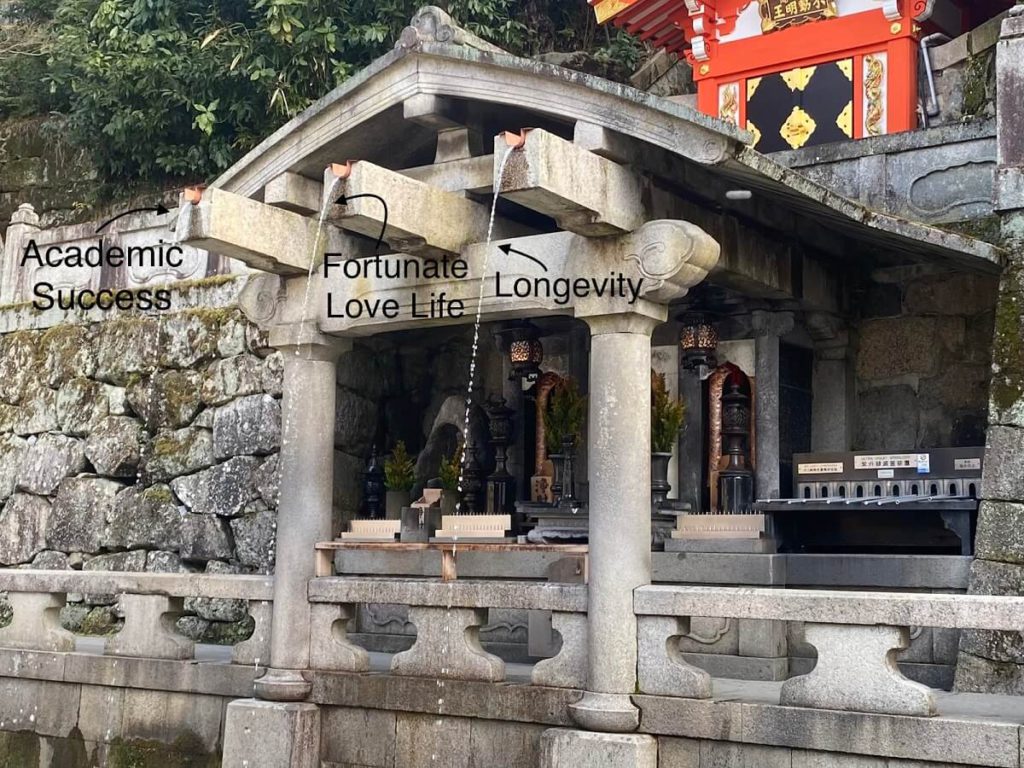
21. Night Illumination
I’d like to end by sharing Kiyomizu-dera’s fascinating night time views.

This temple is open to the public at night three times a year, for a week in spring, three days in summer, and two weeks in autumn. We can enjoy the fantastic atmosphere of the temple lit up with cherry blossoms in the spring, and the autumn leaves in the fall.
How did you like Kiyomizu-dera Temple? Were you captivated by its allure? Hopefully, this article helps you enjoy Kiyomizu-dera.
For the historical and religious sites and other common information about this temple, please click the following link.
Kiyomizu-dera Temple
kiyomizudera.or.jp/en/
Born and raised in Kyoto. A private tutor and a volunteer tour guide in Kyoto. Love sewing, kimono remaking, traveling, cooking, gardening, playing the shamisen(三味線), making stained glass and grandparenting as well.

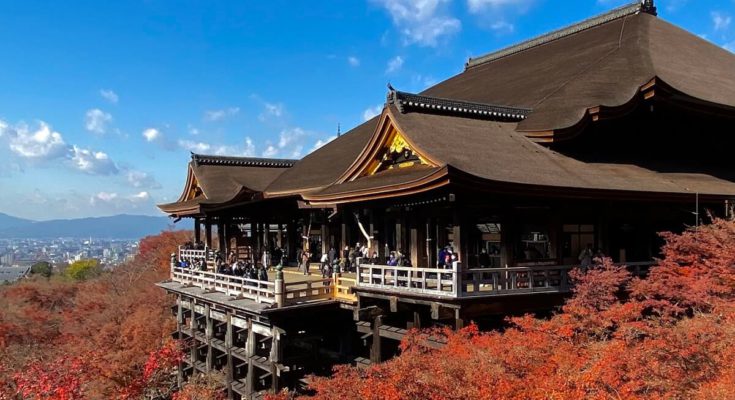
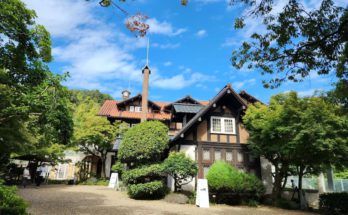
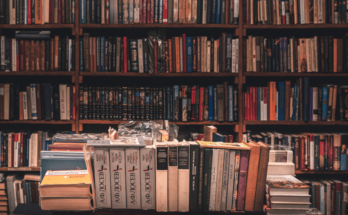
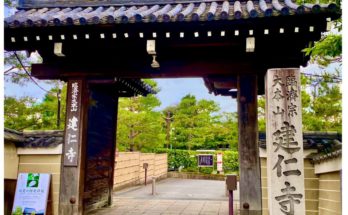
 HTJ has a YouTube page! Check it out
HTJ has a YouTube page! Check it out
Perfect guide I’ve ever met!
仁王門を潜る前から音羽の滝まで、順序よく分かりやすく解説されていて、流石です😃
これでもう見落しません!
写真も美しく、写真に添付されている説明もいいですね~😃
私もRiekoさんにガイドされたい💝
Hi Masayo san!
Thank you for your comment!
I’d like to think this article helps visitors see each spot in order without overlooking it even in the crowd. Fortunately, I was able to take some nice photos with very few visitors a couple of months ago, because of the situation of COVID-19.
Let’s walk around Kyoto again 🥰❗️
Rieko was an amazing tour guide!! We enjoyed Kiyomizu-dera Temple immensely.
Hi Maureen! Thank you for your warm-hearted comment! I also remember we had a wonderful time there😊‼︎ I hope to see you again in Kyoto!
Spasibo for guide! The guide helped us to learn things about Kiyomizu-dera. Wonderful place! Hope to come back one day.
Hello Olga!
Thank you for your comment!
I’m glad to hear that my article helped you learn a lot about Kiyomizudera!
I also hope you visit the temple soon again!